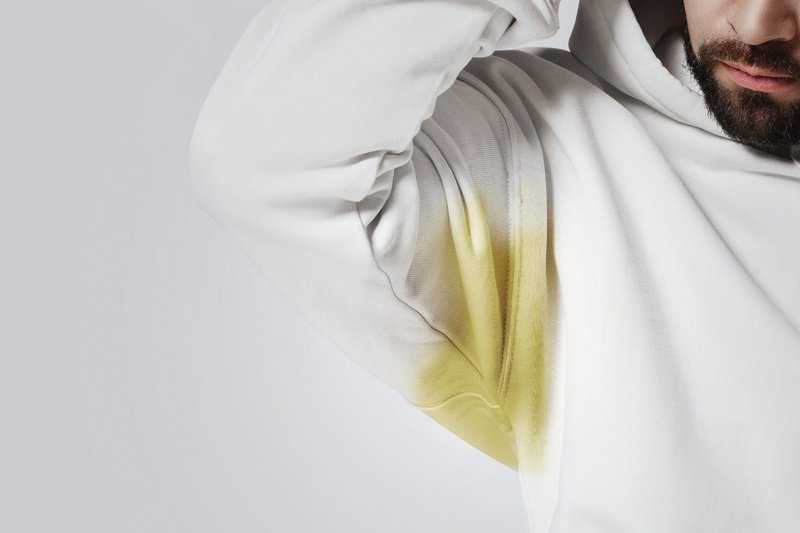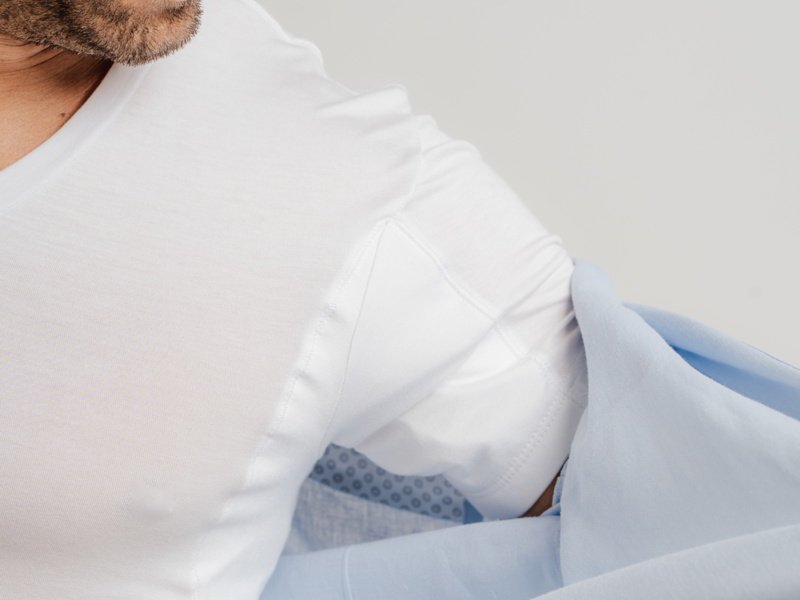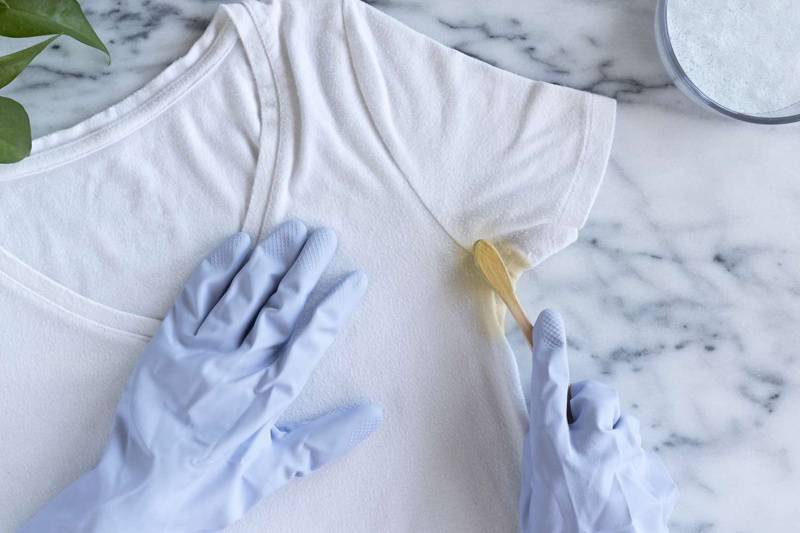How to Avoid Sweat Patches on Clothes: Stay Dry Tips
Tired of sweat stains ruining your favourite shirts? Understand the real cause: often it’s not just sweat, but a reaction between antiperspirant aluminum and proteins causing yellowing, exacerbated by certain fabrics. Want to know how to avoid sweat patches on clothes effectively?
This guide delves into the science, explaining fabric impacts (like polyester’s tendency to hold stains/odors) and offers practical solutions. Learn proactive prevention through smart personal care choices, strategic clothing selection (breathable fabrics, undershirts), and essential laundry practices to stop stains setting. Protect your wardrobe and keep garments looking fresh and clean.
1. Understanding why sweat patches and stains form on clothing
1.1 Sweat composition, bacteria, and product interactions
Sweat itself is primarily composed of water and salts. However, human perspiration also contains small amounts of proteins and lipids. While fresh sweat is largely odorless, the characteristic body odor arises when naturally occurring skin bacteria metabolize (break down) these components, particularly the lipids and proteins present in sweat from apocrine glands (glands concentrated in areas like the armpits).
The more significant issue for clothing, especially concerning visible discoloration, stems from a chemical reaction. Many antiperspirants contain aluminum compounds designed to reduce wetness by temporarily blocking sweat glands.
When these aluminum compounds mix with the proteins present in sweat, a reaction occurs. This protein reaction, upon contact with fabric fibers, leads to the formation of those persistent yellow stains, which are particularly noticeable on light-colored clothing.
This interaction is the most common stain cause behind yellowed underarms on shirts. While rare conditions like Chromhidrosis (where sweat itself is colored) exist, the aluminum-sweat protein reaction is the typical culprit for everyday perspiration marks turning yellow. Understanding this specific sweat composition interaction is crucial for stain prevention.

1.2 Fabric matters: How material choice impacts stain visibility and retention
The type of fabric significantly influences how sweat affects a garment’s appearance and freshness. Fabric breathability plays a vital role. Natural fibers like cotton, linen, and lightweight wool generally allow moisture vapor to pass through more readily, aiding evaporation and keeping the wearer cooler. While they absorb moisture, which can lead to temporary wet patches, the breathability helps manage overall dampness.
In contrast, many synthetic fibers, such as polyester and nylon, tend to be less breathable and possess hydrophobic (water-repelling) properties. While some synthetics are engineered for moisture wicking (pulling sweat away from the skin), their fiber structure, particularly that of polyester, can readily trap oil-based components from sweat and skincare products.
This characteristic contributes significantly to odor retention, as bacteria thriving on these trapped oils become harder to wash out, leading to lingering smells even after laundering. The way stains appear can also differ; synthetics might show wetness differently and hold onto the residue causing yellowing if aluminum products are used.
Furthermore, garment construction impact, such as a very tight weave, can reduce airflow regardless of the fabric type, exacerbating moisture buildup. Careful consideration of fabric care and material selection is therefore essential for managing sweat-related issues in clothing lines.
2. Proactive prevention: Personal care habits and product selection
Beyond choosing the right fabrics, daily routines and product choices significantly impact sweat management and garment protection. Implementing strategic personal care habits can minimize the potential for sweat patches and stains before they occur.
2.1 Antiperspirant vs. deodorant: Choosing and using them for optimal clothing protection
Understanding the distinction between these products is key to effective use and stain prevention methods. The primary antiperspirant function relies on aluminum compounds that temporarily plug sweat glands (mainly eccrine glands, responsible for watery sweat), reducing the amount of moisture released onto the skin. Conversely, the deodorant function is primarily focused on controlling body odor by targeting and neutralizing the bacteria on the skin that cause smell; deodorants do not typically prevent wetness.
For optimal results and minimal transfer to clothing, consider these application tips:
- Apply antiperspirant or deodorant to completely dry skin. Applying to damp skin reduces effectiveness and increases the likelihood of product rubbing off onto clothes.
- Use a thin, even layer. Over-application doesn’t necessarily increase efficacy and can lead to residue buildup on garments, potentially causing stiffness or contributing to deodorant stains.
- Allow the product to dry fully before dressing.
- Consider nighttime application timing for antiperspirants. Sweat glands are generally less active at night, allowing the aluminum compounds more time to be absorbed and effectively block sweat production the following day. This can improve antiperspirant use effectiveness.
Choosing an aluminum-free deodorant eliminates the specific chemical reaction between aluminum salts and sweat proteins that causes yellow staining on fabrics. However, be aware that these products will manage odor but not significantly reduce wetness patches.
2.2 The role of underarm grooming and hygiene
Basic personal hygiene plays a supporting role in managing sweat and odor. Reducing armpit hair, whether through trimming or shaving, decreases the surface area where sweat and bacteria can accumulate. This allows antiperspirants and deodorants to reach the skin more directly, potentially improving their effectiveness.
Less hair may also mean slightly less moisture retention in the underarm area. Regular showering is fundamental for maintaining skin cleanliness, washing away sweat and reducing the bacterial load that contributes to body odor, complementing overall underarm care.

3. Smart clothing choices to minimize sweat marks
Selecting the right garments involves more than just aesthetics; strategic choices in fabric, fit, and layering can significantly reduce the visibility of sweat marks and protect clothing integrity.
3.1 Prioritizing breathable fabrics for better airflow
A fundamental aspect of managing sweat is selecting breathable fabrics. Materials such as cotton (especially in lighter weaves like poplin or voile), linen, Tencel™/Lyocell (regenerated cellulose fibers known for smoothness and moisture management), and lightweight wool possess natural properties that facilitate air circulation.
Their fiber structures allow moisture vapor from sweat to pass through and evaporate, helping to regulate body temperature and keep the skin feeling drier. This inherent breathability reduces the likelihood of large, visible damp patches forming.
For businesses developing clothing lines, prioritizing fabric choice towards these materials, particularly for garments worn close to the skin or in warmer conditions (like cotton shirts or linen clothing), can enhance wearer comfort and minimize visible perspiration marks, directly impacting customer satisfaction and garment appeal. A natural fibers comparison often highlights superior breathability over many standard synthetics.
3.2 The importance of fit: Loose vs. tight clothing
The clothing fit plays a surprisingly significant role in sweat mark visibility. Tight garments press fabric directly against the skin, trapping heat and allowing sweat and any applied product residue (like antiperspirant) little room to dissipate.
This close fabric contact maximizes the transfer of moisture and residues onto the material, making sweat patches more apparent and potentially contributing to staining. Conversely, loose clothing creates space between the skin and the fabric.
This gap allows for better airflow, facilitating evaporative cooling and reducing direct contact between sweaty skin and the garment. While not eliminating sweat, a looser fit often minimizes the appearance of distinct sweat marks.
When considering clothing selection or design, opting for slightly relaxed silhouettes, especially in areas prone to sweating like the underarms, can be a practical strategy against visible heat trapping and moisture marks.
3.3 Undershirts: A crucial barrier against sweat stains
Employing an undershirt serves as a practical protective layer between the body and the primary outer garment. A standard cotton undershirt acts as a sweat barrier by absorbing perspiration before it can reach and saturate a more expensive dress shirt, blouse, or knit.
This absorption helps maintain the appearance and extends the garment longevity of the outer layer, offering essential clothing protection. For individuals who experience heavier sweating, specialized sweat-proof undershirts are available.
These often feature integrated panels in the underarm area made from impermeable or highly absorbent materials designed to completely block sweat from passing through. While a more specific product, the fundamental principle remains: using an undershirt—whether standard cotton or specialized—is an effective way to preserve outer garments from direct sweat exposure and potential staining.

4. Essential laundry practices for stain prevention and garment care
Proper laundering is not just about cleaning; it’s a critical step in preventing permanent stains and preserving the lifespan and appearance of garments. Certain techniques are particularly important when dealing with sweat-affected clothing.
4.1 Act fast: The importance of prompt washing
One of the most crucial aspects of effective laundry care for sweaty garments is timing. Allowing clothes damp with perspiration to sit in a hamper or laundry pile is highly detrimental. Delay permits sweat, body oils, bacteria, and antiperspirant residues (especially aluminum compounds) to deeply penetrate and interact with fabric fibers.
This delay significantly increases the chance of permanent stain setting, particularly the yellowing associated with aluminum reactions, and allows odors to become deeply ingrained. For optimal immediate garment care and preventing perspiration marks from becoming permanent fixtures, prompt washing or at least rinsing sweaty clothes as soon as possible after wearing is essential.
Poor hamper habits directly contribute to difficult-to-remove stains and odors, ultimately shortening the usable life of the garment – a key concern for businesses managing inventory value.
4.2 Best practices for washing sweaty clothes
When washing clothes affected by sweat, specific practices can make a significant difference in outcome and fabric care:
- Use cold or cool water: Contrary to intuition, hot water should be avoided for sweat stains. Heat can effectively “cook” the proteins present in sweat, causing them to bind more firmly to the fabric fibers and making stains, especially yellow ones, permanent. Opt for cold water washing or cool settings on your washing machine settings.
- Choose appropriate detergent: Use a quality laundry detergent choice suitable for the specific fabric type. Enzyme-based detergents can be particularly effective at breaking down protein-based stains like sweat.
- Avoid chlorine bleach on yellow stains: This is critical. While chlorine bleach is often used for whitening, it can react negatively with the aluminum compounds responsible for yellow underarm stains, often making the discoloration darker and more permanent. Strictly follow instructions on avoiding bleach for these types of stains.
- Consider oxygen bleach (with caution): For white or colorfast light-colored items, oxygen bleach (sodium percarbonate) *may* help lift stains. However, always perform a spot test on an inconspicuous area first to ensure it doesn’t cause discoloration or damage.
Simple laundry guide for sweat stains
| Fabric type | Recommended water temp | Detergent type | Bleach warning |
|---|---|---|---|
| Cotton (white) | Cold / cool | Enzyme-based / quality | NO chlorine bleach on yellow stains; test oxygen bleach |
| Cotton (color) | Cold / cool | Color-safe / quality | NO chlorine bleach; test oxygen bleach |
| Polyester/blends | Cold / cool | Quality, suitable for synth | NO chlorine bleach on yellow stains |
| Linen | Cold / cool | Gentle / quality | NO chlorine bleach on yellow stains |
| Wool / silk | Cold (hand wash pref.) | Wool/silk specific | NO bleach of any kind |
4.3 Pre-treating vulnerable areas before washing
For stubborn or concentrated sweat marks, particularly in the underarm area care, applying a pre-treatment directly to the affected zone before the main wash cycle can significantly improve results. This step helps to break down oils, proteins, and product residues before the garment goes into the machine. Consider these laundry tips and stain removal techniques:
- Baking soda paste: Mix baking soda with a small amount of water to form a paste. Gently rub it onto the stained area and let it sit for 15-30 minutes before washing.
- Liquid detergent: Apply a small amount of liquid laundry detergent directly onto the stain and gently rub the fabric together. Let it sit for 5-10 minutes.
- Dish soap & hydrogen peroxide (use with extreme caution): For white or demonstrably colorfast light-colored items ONLY, a mixture of one part dish soap (choose one without dyes or heavy fragrances) and two parts 3% hydrogen peroxide can be effective. Apply to the stain, let sit for about 30 minutes, then rinse thoroughly before washing. Always perform a spot test in an unseen area first, as hydrogen peroxide use (caution) is advised due to its bleaching potential. This method acts as a potent stain remover but carries risk if not used carefully.

5. Addressing lingering odors in clothing
Even after seemingly thorough washing, some garments, particularly those made from synthetic materials, can retain unpleasant smells. This persistent odor retention is often linked to the inherent properties of the fibers themselves. The issue of odors in synthetic fabrics, especially noticeable with polyester, arises because these materials are often oleophilic, meaning they readily attract and bind with oils.
Body oils secreted in sweat, along with the bacteria that feed on them, can become trapped deep within the synthetic fiber structure. Regular washing might remove surface dirt but fail to fully dislodge these embedded oily residues and bacteria.
For deep cleaning clothes suffering from stubborn smells, occasional targeted treatments can help. One common approach involves soaking the affected garment(s) in a dilute white vinegar solution before the main wash cycle.
A mixture of approximately one part white vinegar to four parts cool water can help break down residues and neutralize odors. Allow the items to soak for at least 30 minutes to an hour. Alternatively, specialized laundry boosters formulated specifically for bacteria removal and body odor control can be added to the wash cycle according to product instructions.
Regardless of the method chosen, always ensure garments are thoroughly rinsed after any soaking treatment and before proceeding with regular washing to remove any lingering vinegar smell or treatment residue.
6. Related questions
Addressing common queries can provide further clarity on managing perspiration and its effects on clothing. Here are answers to frequently asked questions (FAQs) related to this related topic:
6.1 Can my diet affect how much I sweat?
Yes, diet influences sweating is a real factor for some individuals. Consuming caffeine, spicy foods, alcohol, and highly processed foods can potentially increase perspiration. Conversely, staying well-hydrated and maintaining a balanced diet rich in fruits, vegetables, and magnesium may help regulate body temperature and contribute to overall sweat management.
6.2 Do natural deodorants prevent sweat stains?
Natural remedies like aluminum-free deodorants focus on combating odor, typically using antibacterial ingredients or ingredients that alter skin pH to make it less hospitable for bacteria. They do not contain aluminum salts, which are the active ingredients in antiperspirants that block sweat pores. Therefore, while natural deodorants effectively prevent the specific yellow stains caused by the aluminum-sweat reaction, they do not prevent wetness patches from forming. This solution type addresses odor and aluminum stains, but not dampness itself.
6.3 What if I sweat excessively all the time?
Excessive sweating unrelated to heat or exertion could indicate Hyperhidrosis, a medical condition characterized by sweating beyond what’s necessary for normal body temperature regulation. If over-the-counter antiperspirants and the preventative measures discussed aren’t sufficient, consulting a doctor or dermatologist is recommended.
They can diagnose the condition and discuss potential treatments, which might include prescription-strength antiperspirants, oral medications, Botox injections, or other medical procedures for sweat management. Standard tips help, but may not be enough for managing Hyperhidrosis.
6.4 Are sweat shields or pads effective?
Yes, sweat shields (also known as underarm pads or dress shields) are a viable solution type for sweat management. These are typically disposable or reusable pads that adhere directly to the inside of a garment’s underarm area. They function as a physical barrier, absorbing sweat before it can reach the outer fabric, effectively preventing visible wet patches and potential stains on the main clothing layer.
Read more:
Successfully preventing sweat damage and stains on clothing hinges on a multi-faceted approach. Understanding the core causes – notably the reaction between antiperspirant aluminum and sweat proteins, as well as fabric properties – empowers effective action.
For businesses operating in the apparel industry, implementing and advising on these practices translates directly to tangible benefits. Consistent clothing maintenance protects the garment quality and aesthetic appeal of inventory, preserving clothing value protection and extending product lifespan.
Ultimately, ensuring garments look their best helps uphold brand value and customer satisfaction. Consistent care preserves the value woven into every garment. For specialized guidance on maintaining your unique apparel lines, expert garment care advice can provide tailored solutions.






















